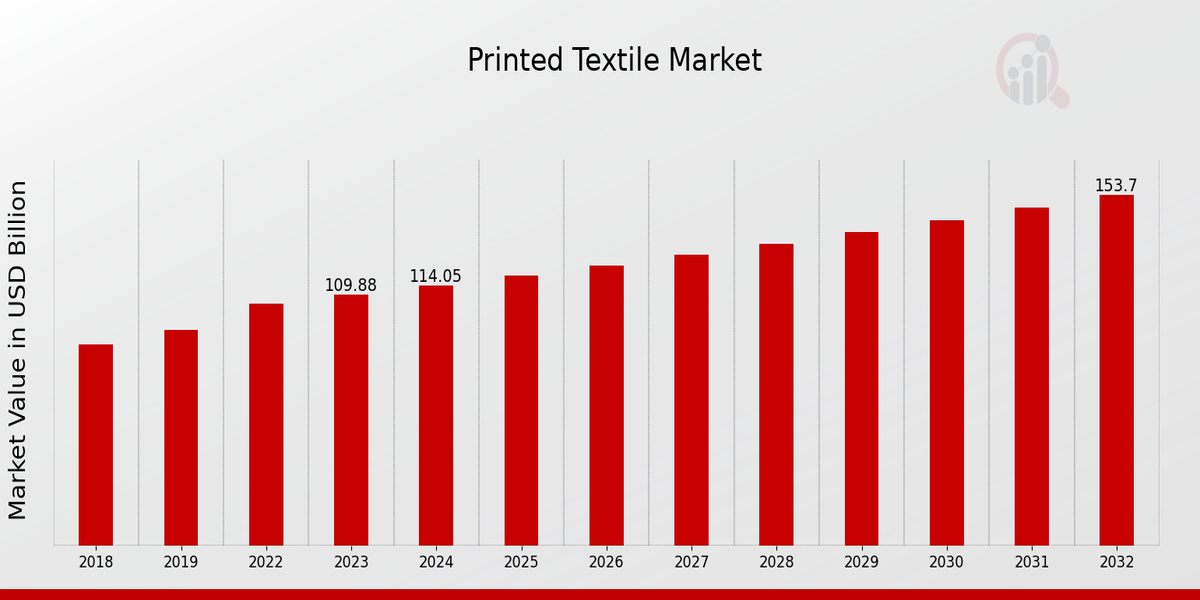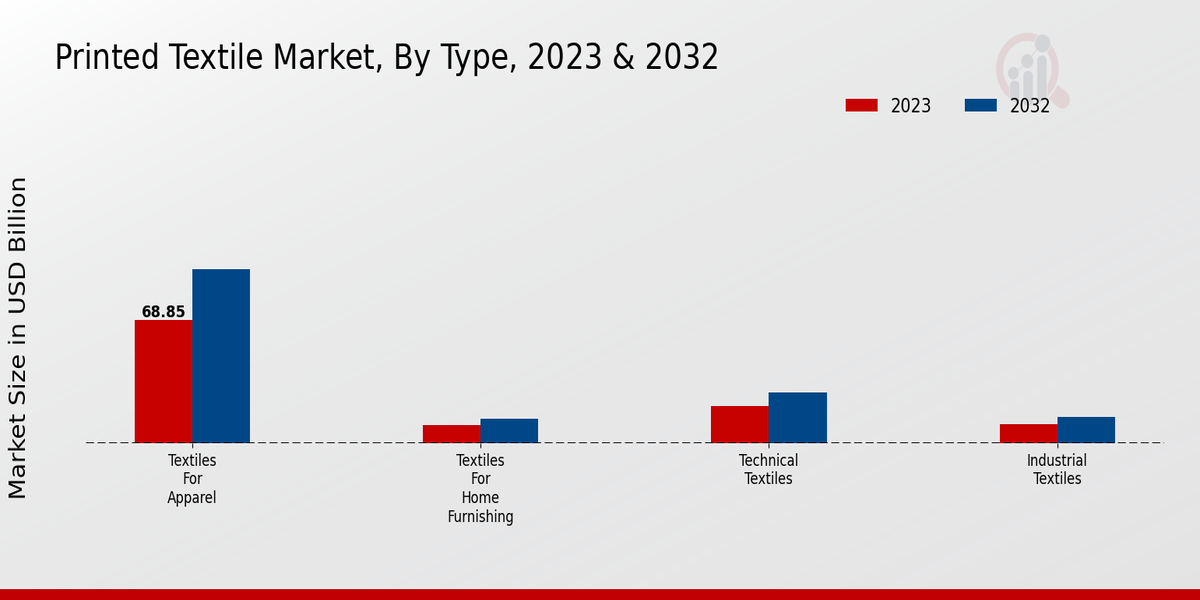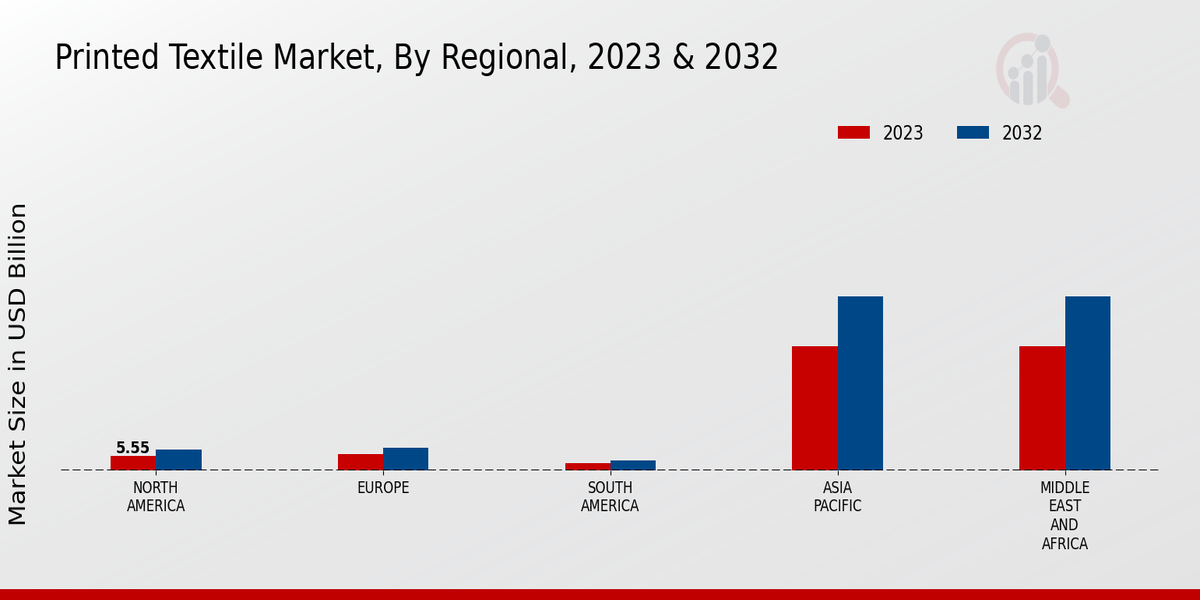Global Printed Textile Market Overview
The Printed Textile Market Size was estimated at 118.46 (USD Billion) in 2024. The Printed Textile Industry is expected to grow from 122.99 (USD Billion) in 2025 to 172.34 (USD Billion) by 2034. The Printed Textile Market CAGR (growth rate) is expected to be around 3.8% during the forecast period (2025 - 2034).
Key Printed Textile Market Trends Highlighted
Growing demand for customized textiles, digital printing technology’s advent, and the growing popularity of home décor and fashion drive the printed textile market. With digital printing, intricate designs can be created, and this has resulted in personalized textiles. The fashion industry is also a major consumer of printed textiles, especially those that are eye-catching or very fashionable. There is also support from e-commerce sector growth, where consumers can easily access printed textiles from various suppliers.
The key possibilities in the field of printmaking include embracing sustainable printing methods, creating functional fabrics, and moving into emerging markets. These eco-friendly products help to reduce environmental damage as well as satisfy the growing need by customers for less harmful products. Functional fabrics have additional properties such as flame retardant, moisture wicking, and antimicrobial properties, thereby bringing about new applications in areas like healthcare and sports, among other sectors. As urbanization takes root, emerging markets present significant growth opportunities owing to the rise in consumer power.
Some current trends in printmaking comprise on-demand printing, AI adoption in design production processes, and AR integration with customer experience. Inventory costs are reduced due to on-demand printing, which allows faster production time. AI aids design processing streamlining, while AR enhances customers’ involvement through virtual trials and customizations.

Source: Primary Research, Secondary Research, MRFR Database and Analyst Review
Printed Textile Market Drivers
- Rising Demand for Personalized and Customized Products
The growing trend of personalization and customization in various industries, including fashion, home décor, and Packaging, is driving the demand for printed textiles. Consumers are increasingly seeking products that reflect their unique style and preferences, leading to a surge in demand for customized printed fabrics. The ability of digital printing technologies to produce high-quality, short-run prints has made it easier for manufacturers to meet this demand, further boosting the growth of the Printed Textile Market Industry.
Technological Advancements in Digital Printing
Advancements in digital printing technologies are revolutionizing the Printed Textile Market Industry. Digital printing offers several advantages over traditional printing methods, including faster turnaround times, lower production costs, and the ability to print on a wider range of substrates. These advancements have made digital printing more accessible to businesses of all sizes, enabling them to produce high-quality printed textiles cost-effectively.The continuous development of digital printing technologies, such as the integration of advanced color management systems and the use of eco-friendly inks, is expected to further drive the growth of the market.
Increasing Adoption of Sustainable Practices
The growing awareness of environmental sustainability is influencing consumer preferences and driving the demand for sustainable products, including printed textiles. Consumers are increasingly seeking eco-friendly and ethically produced products, which is leading to a shift towards sustainable printing practices. The adoption of eco-friendly inks, recycled materials, and energy-efficient printing technologies is becoming more prevalent in the Printed Textile Market Industry.Manufacturers are focusing on reducing their environmental impact while meeting the growing demand for sustainable printed textiles.
Printed Textile Market Segment Insights:
Printed Textile Market Type Insights
The Printed Textile Market segmentation by type is segmented into Textiles for Apparel, Textiles for Home Furnishing, Technical Textiles, and Industrial Textiles. The largest market share in 2023 was held by the Textiles for Apparel segment, which accounted for approximately 45% of the Printed Textile Market revenue. The growth of this segment can be attributed to the increasing demand for personalized and stylish clothing items. The Textiles for Home Furnishing segment is expected to witness notable growth over the forecast period due to the increasing demand for printed home décor products such as curtains, upholstery, and bed linens.
Technical textiles are becoming more popular in various industries like automobile manufacturing, healthcare services, and construction because they possess functional properties such as water resistance, flame retardancy, and UV protection. Industrial Textiles have a lot of applications in many areas, including filtration, Packaging, and protective clothing. The Industrial Textiles segment is projected to grow due to an increase in demand from different end-use industries in the years ahead. All in all, the Printed Textile Market segmentation gives an overview of different types of printed textiles available on the market, along with their applications and future growth potential.

Source: Primary Research, Secondary Research, MRFR Database and Analyst Review
Printed Textile Market Printing Technique Insights
The Printed Textile Market is segmented by printing techniques such as rotary screen printing, digital printing, flatbed printing, and inkjet printing. Rotary Screen Printing had the highest market share in 2023, representing approximately 40% of the total revenue generated from the Printed Textile Market. Over this forecast period, this sector is expected to enjoy a smooth growth curve on account of its cost-effectiveness and ability to produce large quantities. During the foreseen period, digital printing will be the fastest-growing segment, with a CAGR of over 6%. This growth is a result of the growing adoption of digital printing technologies by textile manufacturers, which offer better precision, customization, and shorter lead times for production.
Flatbed Printing and Inkjet Printing are also anticipated to make significant contributions to the Printed Textile Market with increased demand for customized or higher-quality printed textiles.
Printed Textile Market Fiber Type Insights
The fiber type segment of the Printed Textile Market is categorized into natural fibers (cotton, silk, wool), synthetic fibers (nylon, polyester, acrylic), and cellulosic fibers (rayon, Tencel). Natural fibers hold a significant market share due to their breathability, comfort, and eco-friendly nature. Cotton is the most widely used natural fiber, accounting for over 50% of the market. Synthetic fibers offer advantages such as durability, wrinkle resistance, and moisture-wicking properties, making them suitable for sportswear and outdoor applications.Cellulosic fibers are gaining popularity as sustainable alternatives to synthetic fibers, offering similar performance characteristics while being biodegradable. The increasing demand for printed textiles in various end-use industries, such as fashion, home décor, and automotive, is driving the growth of the fiber-type segment.
Printed Textile Market Application Insights
The Printed Textile Market is segmented by application into Fashion Apparel, Home Decor, Automotive, Healthcare, and Packaging. The Fashion Apparel segment was the largest in 2023, accounting for almost half of the total revenue obtained from the Printed Textile Market. The growth of this segment has been driven by an increasing demand for customized and trendy clothing and accessories. Over the forecast period, the Home Decor segment is expected to witness significant growth due to the rising popularity of printed textiles in interior decoration.
The Automotive industry will also see a rise due to the increased need for printed fabrics in car interiors. In addition, there should be a steady growth in healthcare because of the use of printed textiles in wound care and surgical drapes, as well as other medical applications. As far as Packaging is concerned, it will develop at a uniform pace following surging requests for printed textiles across the flexible packaging sector.
Printed Textile Market Product Type Insights
The Printed Textile Market segmentation by Product Type reveals distinct market dynamics and growth opportunities. This industry is driven by Woven Fabrics, Knitted Fabrics, and Non-Woven Fabrics, which are the major segments. In 2023, Woven Fabrics had the largest market share due to their ability to withstand wear and tear flexibility as well as huge applications in clothing, interior design textiles, and industrial textiles. These are followed closely by knitted fabrics, which have a high potential for growth owing to their softness, elasticity, and recent trends like sportswear and casual wear.
The non-woven Fabrics segment has experienced a growing demand for medical and hygiene applications and will demonstrate a regular growth rate throughout the forecast period. The revenue from the global printed textile industry’s woven fabrics sector would amount to $65.54 billion by 2025 at a CAGR of 4.2%. Growth at a CAGR of 4.6% over the forecast period is expected for the knitted fabrics segment, with an estimated market value of USD47.32 billion in 2032. For the non-woven fabrics segment, its CAGR is projected at about 5.1%, while its market size will reach around USD 40.81 billion by 2032. For players operating in the Printed Textile Market, this understanding of the dynamics within each particular segment becomes very crucial.
Manufacturers can take advantage of these opportunities to achieve a competitive advantage by aligning products and strategies to meet specific needs associated with each given segment.
Printed Textile Market Regional Insights
The Printed Textile Market is segmented into North America, Europe, APAC, South America, and MEA. Among these regions, APAC is expected to hold the largest market share in 2023 and is projected to grow at the highest CAGR during the forecast period. The growth in this region can be attributed to the increasing demand for printed textiles in various end-use industries such as apparel, home furnishings, and automotive. North America and Europe are also expected to contribute significantly to the Printed Textile Market revenue, owing to the presence of a large number of textile manufacturers and consumers in these regions.South America and MEA are expected to witness moderate growth in the Printed Textile Market due to the growing demand for printed textiles in these regions.

Source: Primary Research, Secondary Research, MRFR Database and Analyst Review
Printed Textile Market Key Players And Competitive Insights:
The Printed Textile Market industry is highly competitive, with several major players holding a significant market share. Leading Printed Textile Market players are investing heavily in research and development to create innovative and eco-friendly products. Strategic partnerships and collaborations are common in the industry as companies seek to strengthen their market position and expand their product offerings. This competitive landscape drives innovation and product development, ultimately benefiting the end consumer.A key player in the Printed Textile Market is Archroma, a global leader in color and specialty chemicals. Archroma provides a wide range of environmentally friendly textile dyes and chemicals, catering to the specific needs of the printed textile industry. The company's commitment to sustainability and innovation has earned it a strong reputation among industry players and customers alike.Another leading competitor in the Printed Textile Market is Huntsman Corporation, a global manufacturer of specialty chemicals. Huntsman offers a comprehensive portfolio of textile dyes and auxiliaries, serving the needs of both digital and conventional printing processes. The company's focus on technical innovation and customer support has positioned it as a trusted partner for textile manufacturers worldwide.
Key Companies in the Printed Textile Market Include:
- Raymond Limited
- Trident Limited
- Siyaram Silk Mills Limited
- GTN Textiles Limited
- Zodiac Clothing Company Limited
- Vardhman Textiles Limited
- Himatsingka Seide Limited
- Texplast Industries Limited
- Arvind Limited
- KPR Mill Limited
- Donear Industries Limited
- Welspun India Limited
- Sutlej Textiles and Industrials Limited
- Texwinca Holdings Berhad
- Fabindia Overseas Private Limited
Printed Textile Market Industry Developments
The Printed Textile Market is projected to reach USD 172.34 billion by 2034, exhibiting a CAGR of 3.8% from 2025 to 2034. Increasing demand for personalized and customized textiles in the fashion and home décor industries is driving market growth. Digital printing technology advancements, offering higher precision, faster production, and eco-friendliness, are further propelling the market.Recent developments include:- In 2023, Kornit Digital launched the Kornit Presto S, a high-speed digital textile printing solution for industrial-scale production.- Epson introduced the SureColor F-Series dye-sublimation printers, designed for high-volume textile printing applications.- Leading home décor brands are partnering with digital textile printing companies to offer exclusive and customized designs.These developments indicate continued innovation and investment in the printed textile market, supporting its growth trajectory in the coming years.
Printed Textile Market Segmentation Insights
- Printed Textile Market Type Outlook
- Textiles for Apparel
- Textiles for Home Furnishing
- Technical Textiles
- Industrial Textiles
- Printed Textile Market Printing Technique Outlook
- Rotary Screen Printing
- Digital Printing
- Flatbed Printing
- Inkjet Printing
- Printed Textile Market Fiber Type Outlook
- Natural Fibers (Cotton, Silk, Wool)
- Synthetic Fibers (Nylon, Polyester, Acrylic)
- Cellulosic Fibers (Rayon, Tencel)
- Printed Textile Market Application Outlook
- Fashion Apparel
- Home Decor
- Automotive
- Healthcare
- Packaging
- Printed Textile Market Product Type Outlook
- Woven Fabrics
- Knitted Fabrics
- Non-Woven Fabrics
| Report Attribute/Metric |
Details |
| Market Size 2024 |
118.46 (USD Billion) |
| Market Size 2025 |
122.99 (USD Billion) |
| Market Size 2034 |
172.34 (USD Billion) |
| Compound Annual Growth Rate (CAGR) |
3.8% (2025-2034) |
| Report Coverage |
Revenue Forecast, Competitive Landscape, Growth Factors, and Trends |
| Base Year |
2024 |
| Market Forecast Period |
2025-2034 |
| Historical Data |
2020 - 2024 |
| Market Forecast Units |
USD Billion |
| Key Companies Profiled |
Raymond Limited, Trident Limited, Siyaram Silk Mills Limited, GTN Textiles Limited, Zodiac Clothing Company Limited, Vardhman Textiles Limited, Himatsingka Seide Limited, Texplast Industries Limited, Arvind Limited, KPR Mill Limited, Donear Industries Limited, Welspun India Limited, Sutlej Textiles and Industrials Limited, Texwinca Holdings Berhad, Fabindia Overseas Private Limited |
| Segments Covered |
Type, Printing Technique, Fiber Type, Application, Product Type, Regional |
| Key Market Opportunities |
Digital Printing Sustainable Textiles Customization Emerging Markets Home Decor |
| Key Market Dynamics |
1 Increasing demand for digital printing2 Growing consumer preference for customized products3 Advancements in printing technologies |
| Countries Covered |
North America, Europe, APAC, South America, MEA |
Frequently Asked Questions (FAQ) :
The Printed Textile Market was valued at USD 122.99 billion in 2025 and is expected to reach USD 172.34 billion by 2034, exhibiting a CAGR of 3.8% during the forecast period.
Asia-Pacific is anticipated to lead the printed textile market throughout the forecast period due to the increasing demand from countries such as China, India, and Japan.
The primary growth drivers of the printed textile market include the rising demand for personalized and customized textiles, advancements in digital printing technologies, and the growing popularity of e-commerce platforms.
Apparel and home furnishing applications collectively accounted for the largest share of the printed textile market in 2023 and are projected to maintain their dominance during the forecast period.
Major players in the Printed Textile Market include Kornit Digital, Mimaki Engineering, Epson, DTG Digital, and EFI.
Emerging trends in the printed textile market include the adoption of sustainable printing practices, the integration of smart technologies, and the rise of on-demand printing.
The printed textile market is anticipated to witness continued growth in the coming years, driven by factors such as increasing disposable income, urbanization, and changing consumer preferences.
Challenges faced by the printed textile industry include intense competition, fluctuating raw material prices, and environmental concerns.
Opportunities for growth in the printed textile market lie in the expansion of emerging markets, the development of innovative printing techniques, and the growing demand for sustainable textiles.
The COVID-19 pandemic had a significant impact on the printed textile market, leading to supply chain disruptions and a decline in demand. However, the market is expected to recover in the post-pandemic period.

















